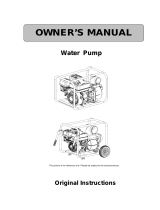
PUMP SAFETY
SAFETY INFORMATION
Your Honda multi-purpose pump is designed to give safe
and dependable service if operated according to instructions.
Read and understand this owner’s manual before operating
your pump. You can help prevent accidents by being familiar
with your pump’s controls, and by observing safe operating
procedures
Operator Responsibility
Know how to stop the pump quickly in case of emergency.
Understand the use of all controls and connections.
Be sure that anyone who operates the pump receives proper
instruction. Do not let children operate the pump without
parental supervision. Keep pets away from the area of
operation.
Pump Operation
Never pump flammable liquids such as gasoline or fuel oils.
An explosion may result causing serious injury.
Pump only those chemicals listed on pages 20 and 21 of
this manual.
Operate the pump on level surface. If the engine is tilted, fuel
may spill.
Prime the pump before operation. Operating the pump dry
will cause seal damage.
Do not enclose the pump in any structure.
The exhaust system gets hot enough to ignite some
materials. Keep the pump at least 1 meter (3 feet) away from
buildings and other equipment during operation.
Carbon Monoxide Hazards
Exhaust contains poisonous carbon monoxide, a colorless
and odorless gas. Breathing exhaust can cause loss of
consciousness and may lead to death.
If you run the pump in an area that is confined, or even
partially enclosed, the air you breathe could contain
dangerous amounts of exhaust gas. To keep exhaust gas
from building up, provide adequate ventilation.
2


























